#Coppernob (locomotive)
Explore tagged Tumblr posts
Text
fuck
@mean-scarlet-deceiver due to your profile picture my mind immediately went to "F.R. crack AU where Coppernob is given control of the Barrow Central PA system (did they have a PA system back then?) and gives color commentary on the daily goings-on of the station"
With at least one "announces the arrival of a seagull and confuses the passengers who think he's still talking about birds" event a day.
shoutout to the guy in charge of the train station at my hometown, who doesn’t limit himself to announcing trains but also:
comments on interesting birds he sees on the platform
gives completely unofficial weather reports on what he thinks the day is going to be like
refers to very crowded trains as ‘friendly trains’
regularly congratulates everyone on having gotten up on time on Monday mornings
basically seems to use the tannoy system to amuse himself and try and brighten up everyone’s morning commute
refers to himself as ‘the fat controller’
#Railway Series Fandom#Railway Series Rubbishposting#friends' ocs#other people's ocs#Coppernob (locomotive)
265K notes
·
View notes
Text
Happy Train Fiend Day to all who celebrate!
Let's have some sexy Victorian trains, all photos and descriptions courtesy of the National Railway Museum in York.

Steam locomotive and tender, London & North Western Railway, 2-4-0 No 790 "Hardwicke", designed by F.W.Webb, built at Crewe in 1873, withdrawn 1932. (source)

Steam locomotive, London & South Western Railway, 2-4-0WT No 298, 'Beattie Well Tank', designed by W.G. Beattie, built in 1874, withdrawn in 1962. Renumbered 30587 by British Railways. (source)
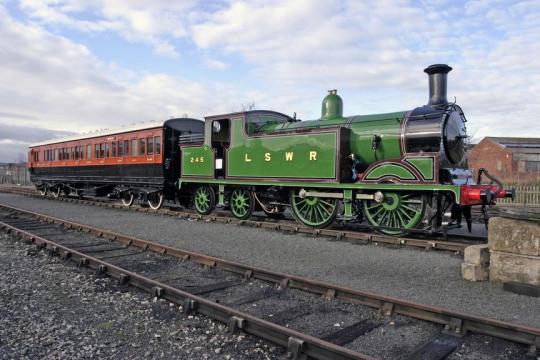
Steam locomotive, London & South Western Railway, M7 class 0-4-4T No 245, designed by Dugald Drummond, built at Nine Elms in 1897, withdrawn in 1962. (source)
If we take a 1897 setting for Dracula, then this would be the kind of brand new train that Mina would get very excited about.
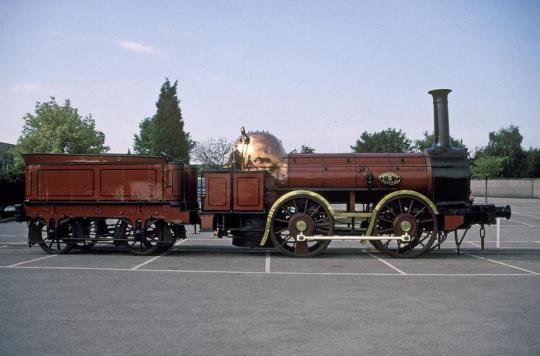
Steam locomotive and tender, No 3, 'Coppernob', 0-4-0, for Furness Railway, designed by E Bury, built by Bury, Curtis and Kennedy in 1846, withdrawn in 1900. (source)
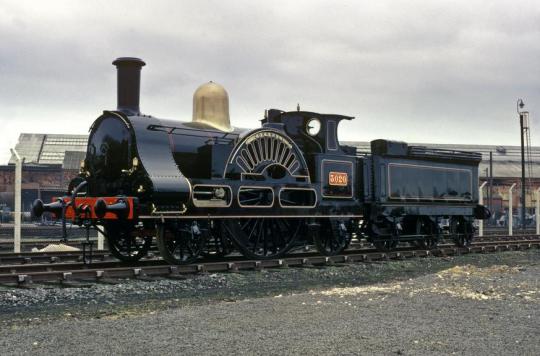
Steam locomotive and tender, London & North Western Railway, 2-2-2 No 3020 "Cornwall", designed by Trevithick, built at Crewe in 1847, withdrawn in 1927 and components. (source)
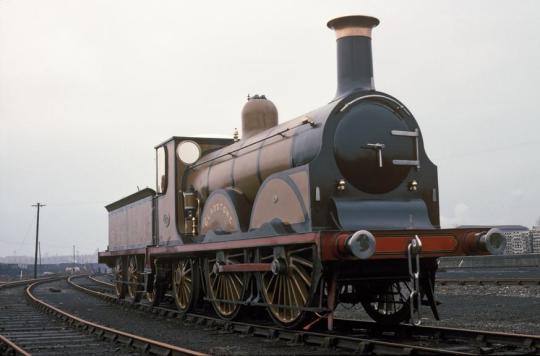
Steam locomotive and tender, London Brighton & South Coast Railway, 0-4-2 No 214, "Gladstone", designed by William Stroudley, built at Brighton in 1882, withdrawn 1927. (source)

Steam locomotive and tender, Great Northern Railway, 4-2-2 No 1, designed by Patrick Stirling, built at Doncaster in 1870, withdrawn in 1907. (source)
124 notes
·
View notes
Text
Traintober 2023: Day 27 - Record-Breaker
Mallard Broke the World Speed Record; It Broke Her:

4468 Mallard broke the world steam speed record in 1938, changing her life forever…
1938:
The quiet, almost timid engine sat in the works, listening to the workers. “You hear? That engine there is fastest in the world!” one said, pointing to the famous engine. Mallard blinked, amazed. She’d never been told if she’d actually broken the record – but to hear that she had, and to hear that it was major news! It was incredible.
There was no one better than her in that moment – she was the greatest!
“Ah, the engine of the hour!” cheered a voice. Mallard gazed down, spotting Sir Nigel Gresley himself walking over. Mallard gasped in amazement. The Chief Mechanical Engineer almost never visited his engines. “I came to congratulate you again, Mallard. I am proud of you – you are truly a credit to this railway. The poster child for what every Northeaster engine should strive for. Well done, and keep up the good work, Mallard.”
Mallard beamed, thanking her designer. Then, she turned to the gossiping workers. “Well? You heard him – I need to be back in service now! Hurry it up!”
1963:
“So, which of us is to be preserved?” asked Silver Link, staring down apprehensively at the members of the British Railways board. The men had come to decide on a Gresley Pacific to save from the scrapper’s torch.
“Who do you think?” snorted one of the men in the bowler hats. “We must choose the locomotive that achieved the greatest feat of a steam locomotive – 60022 Mallard, you are to be restored to your LNER looks and sent to the Museum of British Transport Museum. The rest of you… hope someone purchases you.”
Silver Link just stared in shock as several diesels sniggered in the background. “But I… but… She didn’t even make it back to London! I am the first! I reached 114—” “Stop speaking 60014, there is no reason for you to complain. You are already withdrawn, and shall be sent away once we have the time.” “Mallard… are you going to allow this?” asked Silver Link, eyes wide in horror. “Well, elder sister, some of us are just… more important than others. I represent our class, and I am the best at such an honour.” Silver Link went red in the face, but Mallard was already steaming away, blowing smoke at her elder sister.
Behind Silver Link, Flying Scotsman and Silver King shared a nervous look.
1975:
Flying Scotsman sat on the points outside the brand new York National Railway Museum, Green Arrow on one side and Gordon on the other. It was the first time that the four had seen each other – the fourth being an indignant Mallard sat opposite them.
“What do you mean, he’s worthy of being the same level as me?” sniffed Mallard. “He’s a mixed traffic engine!” “Green Arrow is an LNER engine, same as us,” reminded Scott crossly, facing down his cousin. “And there are only nine LNER Pacifics left, so your levels are completely worthless! We need to end this… this… this…” “Elitist garbage!” Gordon snapped. “We are long past this, cousin. What’s stopping you from accepting Green Arrow?” “Green Arrow is a simple mixed traffic engine,” hissed Mallard. “I am the greatest steam engine to have ever been built! No one has ever, or will ever, beat my record. There’s a reason that I am in this museum, and you are out slaving away to keep in steam.”
“Slaving away?!” Gordon let off steam furiously. Scott just clenched his jaw. “There’s no point arguing with her,” he sighed. “We’re better off just getting the rest on side.” The three steamed away, leaving Mallard to be pushed gently back into the grand museum by a timid diesel shunter.
None of the other engines in the museum spoke to her as she was shunted into place. Not Evening Star, not Aerolite, not Coppernob. They all just shot her dark glances.
1988:
Mallard sped along the line, feeling the wind rush past her face. “I forgot what this was like,” she huffed, finally arriving back at Doncaster after crossing the country to reach Scarborough and back. Several relatives of her crew from back when she’d broken the world record sat in her coaches – but they were inconsequential. After all, any crew could have gotten her up to her record-breaking speed.
“So, how was the run?” asked Gordon politely, sitting in the next platform over. Mallard ignored him. Gordon rolled his eyes. Green Arrow and Spencer shared a look.
“I’m impressed,” hummed Spencer. “Though I’ve heard that the East Germans have built a steam locomotive that’s almost able to match Mallard’s speed.” Mallard’s eye twitched. “No they haven’t!” she suddenly snarled, spooking several of the passengers on the platform. “I am the fastest. That’s my role! Don’t talk such drivel around me.”
Spencer sighed. As the only one of Mallard’s siblings willing to speak to her, and one of only four engines that had spoken to Mallard (he’d checked with Duchess of Hamilton) in the last ten years, he was uniquely able to see just how much his younger sister had changed.
Where Mallard had once been a healthy pale, her pallor had grown almost dangerously blue – while her formerly vibrant eyes had gone dull, with just a hint of something… unsettling in them. And yet her paintwork was spotless, her brass polished until it glistened in the sun, even after a full run with passengers.
“Are you alright?” asked Spencer quietly. Gordon and Green Arrow pretended not to hear. “I beg your pardon?!” roared Mallard, spooking yet more passengers. “Are you insinuating something?! That such a simple run would tire me out? I am the fastest steam engine in the world – I am more than competent, thank you.” “I just wanted to ch—” “Well don’t!” sneered Mallard. “I am fine.”
Spencer’s tentative frown turned downwards into a scowl, and the great silver engine hissed steam as he started away. Gordon watched him go, knowing deep in the pit of his boiler that the silver engine wouldn’t be back.
Silver King had never truly forgiven his younger sister for the way she’d spoken to Silver Link, even if his name had changed, as had his owners and his lifestyle.
2013:
Spencer, Bittern, Dominion of Canada, Dwight D Eisenhower, Union of South Africa, and Sir Nigel Gresley all stood in awkward silence. Their sister – Mallard – was being wheeled out of the museum for a photoshoot. “So… did you hear her last night?” asked Dwight quietly. “She was screaming at the shunting diesels again.” “I can’t believe they made me agree to his,” hissed Spencer. “I promised myself after 1988 – never again. And yet here I am. At least Scott gets to hide in the workshops.” “It cannot be that bad?” tried Woodcock – only the humans called her Dominion of Canada, “I mean… she has to have made some friends in there, right?” “Unlikely,” snorted Osprey – the humans had given her that name in the 1980s, and she much preferred it to ‘Union of South Africa’, “she spends most of her days just glaring at everyone. Last I heard, it’s a real treat for them when she gets brought out here to be gawked at.”
“Shh! Shh! She’s coming,” warned Bittern. The six all went silent as Mallard was dragged off the turntable and over to the line of engines.
“Ah, good, you all made it,” Mallard said haughtily. “It’s what I deserve, getting the humans to bring you all here to celebrate our class’s greatest achievement.” “What you—” Osprey cut off, indignant. Beyond her, Dwight gawked in shock while Spencer just rolled his eyes. The shunter braked the famous engine to a stop, jolting slightly.
“Did you just jolt me?” hissed Mallard, voice deathly quiet. The shunter gulped. “Don’t you dare!” snapped Spencer, speaking to the world-record holder for the first time in nearly thirty years. “You cannot deride these hard-working engines, I refuse to allow it!” “Oh? As if you are any better, Mr Private Engine,” sneered Mallard. “Silver King, the weird runt of the class who galivants off to that backwards island where our Crewe-rebuilt cousin lives.” “Gordon still pulls his express!” roared Spencer, letting off steam furiously. “Gordon treats everyone with respect! He’s a far better representative of our railway than you are – he’s out there, pulling passengers and acting as the ambassador for Gresley’s work. He holds a record for the longest-serving express engine in the world!”
“He has Midland parts,” snarled Mallard. “He’s a mongrel of parts, and I can’t stand him! I can’t stand him and his righteousness! This is my celebration, my record, my museum! He can talk when he has a proper record of his own. Let’s see him try and beat me – oh wait, didn’t he lose his dome last time he attempted that?”
None of the other A4s spoke, and the moment the photoshoot was over, all four in steam left, taking Dwight and Woodcock with them, leaving Mallard alone.
2016:
Flying Scotsman sat outside the NRM, steam wafting from his funnel. He was the last one left. Spencer had permanently relocated to Sodor after 2013, the other A4s steered clear of York Museum, Gordon had his own work, and Green Arrow had moved to Shildon. So, it was only him left to talk to her.
“Oh, it’s the money pit.” “Mallard. I came to say goodbye.” “Goodbye? Where are you going, Gresley Disgrace?” “I’m going to run mainline excursions,” Flying Scotsman replied evenly. “I’m not going to have to listen to you anymore when you scream abuse at the others or rant about the new PRR engine.” “Rant? Abuse? 4472, you don’t understand! I am Gresley’s pride and joy! I am the greatest – he would roll over in his grave if he saw you now. It’s my destiny to be the greatest – and everyone needs to accept that!” “Sir Nigel Gresley loved us all equally,” snapped Flying Scotsman. “And don’t you forget, any one of your class—”
“I did it!” roared Mallard. “Me! Not any of you! I am the world record breaker – I am the greatest steam engine of all time! You’re nothing compared to me! I am Sir Nigel’s triumph! I am the legacy of the Northeasters! Me! How dare you speed to me like that?! Learn your place!”
Flying Scotsman stared evenly back at the shrieking engine. “I have,” he said simply. “And it’s not here. The other engines can survive listening to your abuse, but I don’t have to. You’re nothing, Mallard. Not anymore. You sit here, on this siding, in this shed, and you cling to the past because that’s all you’ll ever have.”
Flying Scotsman puffed out of the shed, the wrecked screams of his cousin following him through the sliding shed doors. They transformed from howls of rage into a hail of screeching tears, as Mallard’s entire self-worth crashed down on her. The former icon of steam and speed finally lost it, all the rage and anger and simmering hatred growing inside her frames boiling over as she cursed her cousin.
Flying Scotsman couldn’t help but feel sorry for the engine – but all the same, she had spent decades wrecking their designer’s good name with her attitude. Her stardom had placed her up on a pedestal – one where the loneliness of fame had engulfed her.
Back to Master Post
#fanfiction writer#railway series#weirdowithaquill#thomas the tank engine#railways#traintober 2023#traintober#ttte mallard#ttte flying scotsman#ttte green arrow#ttte spencer#ttte gordon#mental problems#Mallard loses her humanity
77 notes
·
View notes
Note
Question for the York NRM locomotives: what was it like when Coppernob was a fellow resident? Has he always been a bit of an objectionable fellow to deal with?
HAMILTON: Oh always! It's his way or the mainline according to him. Thankfully he has dialed back the attitude somewhat, but it is still there. Even though he is abrasive and quite difficult to deal with I do feel sorry for him. He's stuck in the past and he desperately wants to return.
I think Stephen helps him though. Maybe one day he will mellow out but I doubt that it will happen anytime soon.
7 notes
·
View notes
Text
What are the odds that Coppernob himself was telling people he was being exhibited without his chimney just to fuck with them / sarcastically answering that he was because he was sick of being asked about it, and making up increasingly stupid lies about the status of his chimney to see what he could get people to fall for?
"My chimney? Well, my lad, it's still embedded in the roof of the first tunnel we ran through, so they're seeing about enlisting a grammar school class to make me a new one from Papier Mache."

Love the weariness you can hear in the tone of that caption. RM must have received a thousand letters in the previous month from fans freaking out.
40 notes
·
View notes
Text

ah yes :) married old engines
#ttte#ttte oc#its the#furness no 3 old coppernob#and#locomotion no 1#look at em#:)#ah two old peeps being quietly in love#my art#my ocs#i have an obsession with old engines#and i mean like... really old
10 notes
·
View notes
Text
My NRM Visit
The other day, me and my mum embarked on a grand adventure to the National Railway Museum. Having previously tried and failed to visit on two previous occasions, we naturally made the most of our day there. I in particular took many, many photos, and there now follows but a small sample of these:
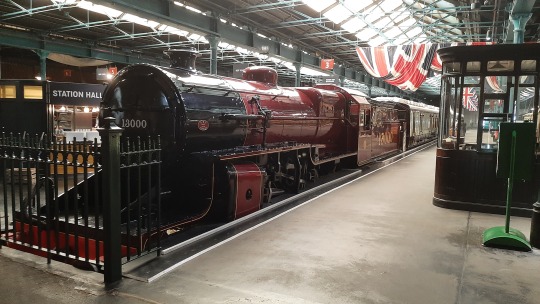
It wouldn’t be a Tumblr post without a crab, and so we start with an LMS Crab 2-6-0 - this is in fact the first of the class, LMS #13000 (later #2700).

LMS Royal Saloon #799. Originally built in 1941 as an armoured saloon for the Queen Mother, who used it to travel around the country to boost morale during the War. This saloon was used by the Royal Family right up until 1977, when the present royal train came into service.

GNR J13 0-6-0ST #1247. This was the first steam engine ever to be privately purchased direct from British Railways, in 1959. Mum for scale.
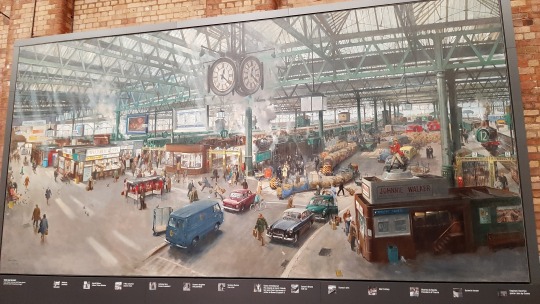
Waterloo Station 1967 by Terence Cuneo. Exactly what it says on the tin. As with all of Cuneo’s paintings, this one is crammed with all sorts of little details and cameos (including his trademark mouse, who is sitting on top of the Johnnie Walker advert to the right).

SECR D Class 4-4-0, #737. Not a whole lot to say about this one that hasn’t been said already. I just included it here to provide context for the next photo. Speaking of which:
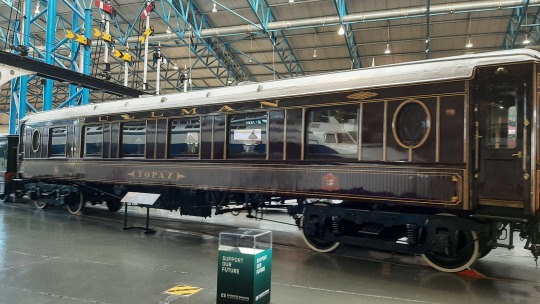
Pullman coach Topaz, with whom #737 currently shares exhibition space. Rather than the traditional chocolate-and-cream, this Pullman carries its original crimson livery, which seems to have been the inspiration for that worn by the Pullmans seen in Thomas.
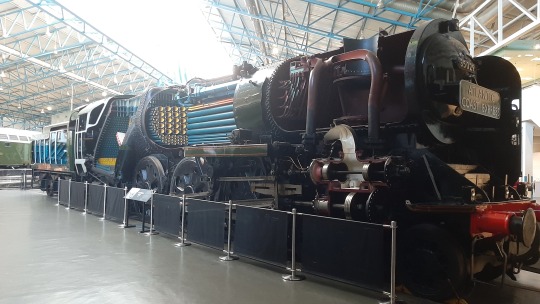
BR (SR) Merchant Navy 4-6-2 #35029, Ellerman Lines. As you can see, she’s been cut in half to more easily demonstrate how a steam locomotive works. Which is pretty neat, even if it does make for a rather grisly spectacle.
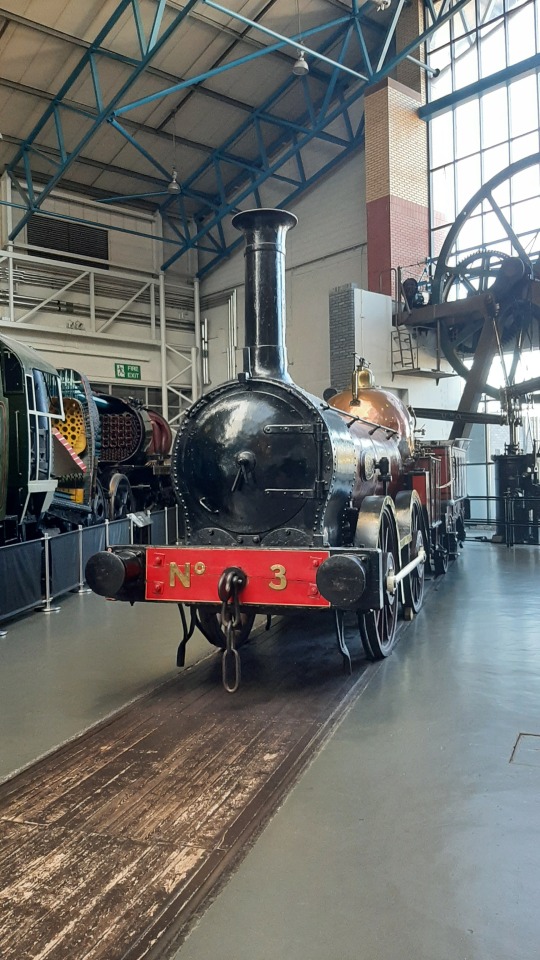
Furness #3 0-4-0, Coppernob. Also known as that engine who used to be on display in Barrow-In-Furness, and still carries literal battle scars from a 1941 air raid on that town. Also also known as Nobby, if you’re @mean-scarlet-deceiver or any of their followers.
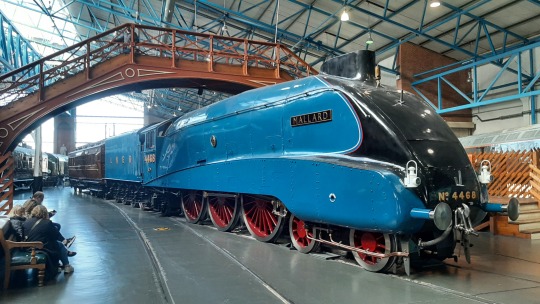
LNER A4 4-6-2 #4468, Mallard. I couldn’t not take a photo of the world’s fastest steam engine (whose 126mph record was quantified by the dynamometer car just visible in the background).

And finally, the little blue bugger himself - specifically an RG Mitchells kiddie ride from about 1994.
#national railway museum#lms crab#royal train#gnr j52#terence cuneo#waterloo station#mouse#scer d class#pullman coach#topaz#ellerman lines#coppernob#mallard#thomas the tank engine#york
36 notes
·
View notes
Video
Furness Railway No.3 "Old Coppernob" by Tom Balson Via Flickr: Furness Railway No.3 "Old Coppernob", is a preserved English steam locomotive. It acquired its nickname because of the copper cladding to its dome-shaped "haystack" firebox It was built in 1846 by Bury, Curtis, and Kennedy of Liverpool, a company with which the F.R.'s first locomotive superintendent, James Ramsden, had been an apprentice. It is a four-coupled version of Edward Bury's popular bar-frame design of the period, with iron bar frames and inside cylinders, and is historically significant as the only survivor in the United Kingdom of this type. It is also one of the few items of rolling stock surviving from the Furness Railway whose Indian red livery it carries. It is now housed in the National Railway Museum, York. It has shrapnel wounds from German bombs, acquired during World War II when it was displayed in a glass pavilion at Barrow-in-Furness station. In February 2007, No. 3 had one of its shedplates stolen at York Taken with a Nikon D7000
5 notes
·
View notes
Photo

Furness Railway steam locomotive 'Coppernob' 0-4-0, No 3, National Railway Museum, York-2.jpg
3 notes
·
View notes
Text
Admittedly I have no idea if the ongoing war would even allow her to be this way, but I suppose she may be in a similar boat to Thomas? He was built and shipped off right at the start of WWI, and yet was still relatively innocent, albeit not to the degree of Rosie... I figure they were both either sheltered from the respective Horrors of War, or it simply did not affect them as deeply as one might think. Man-made horrors beyond locomotive comprehension?
I think Thomas might have been sheltered in WWI, and maybe even the start of WWII. But I can't imagine any engine in Britain being truly sheltered from WWII, even on Sodor. I mean, like...

This is what Barrow Central Station looked like after it was bombed in 1941. This station is the eastern terminus of the NWR since 1925. The engines would've had to take trains here and see the station in this state and the city around it in ruins. (Not to mention that this is like 2 miles from Vicarstown: there were probably air raids on Vicarstown too if nothing else because some bomber pilot read the map wrong). Edward's former colleague, Furness Railway No. 3 Coppernob, had holes punched in his boiler by shrapnel in this bombing (luckily Coppernob had been out of steam for 40 years but still).
Not to mention TFC probably had to give certain engines the "The black wartime livery is not a punishment and it is not because we're about to go bankrupt and have no money for paint: it is for your own safety because if the German bombers see you they will aim for you specifically" talk, as well as the "Why we are making nighttime running so dark and dangerous including turning off or dimming your own headlamps" talk.

This is Sir Ralph Wedgwood / Gadwall, Gordon's cousin, 1942. Age 3 and 8 months. He was sleeping in a shed one night when a bomb came through the roof. I don't think Gordon ever met Gadwall but the news had to have made its way to Sodor.
I think the Blitz would've been a scary, stressful time for everyone on Sodor, but Thomas does seem like the kind of engine whose coping mechanism would be to stay cheerful and upbeat. I can't remember where I read this - it may have been your headcanon, @mean-scarlet-deceiver - that Thomas had a lot of interactions with children who were evacuated to Sudrian towns and did his best to cheer them up, and I really love that idea. And it seems only natural for a young tank engine to latch onto and idolize a role model similar to her and with a kinda similar history.
The only real downside to this HC is that its incompatible with my former pet idea that Rosie was a follower of the Railway Series in the post-war years and her idolization was more akin to a parasocial relationship, and that doesn’t really work if she’s arrived on Sodor and stayed there before the books were even published.
What if she started out working on Sodor but was transferred away later in the war and ended up somewhere else like the SR?
Oh, jesus though... If she ended up as one of the SR's USA class I think she'd even have worked alongside Thomas's siblings... and possibly continued working there for a few years after they were withdrawn. I can definitely see an engine with "childhood" memories of being on Sodor developing a parasocial relationship with her childhood hero and first real friend during the 60s and being obsessed with the RWS as a form of escapism, + trying really, really hard to emulate her "rose-colored" memory of how Thomas acted during the war as a way of coping with her own stress and grief.
Headcanon: Rosie has been on Sodor way longer than you’d think…
World War II is a notoriously glossed over time in Sodor history. On an unrelated note, Rosie is a USATC S100, a class of locomotive that was built in the USA and exported to Europe for the Allies’ war effort. Rosie’s introductory episode is one which does not feature any kind of origin story, nor is she said to be new. She just kinda shows up and is treated as if she’s been a character who’s been around this entire time… I’m sure you can see where I’m going with this… 😈
Keep reading
#Railway Series Fandom#TTTE Fandom#Rosie (TTTE)#traumatized steam engines#other people's headcanons#good headcanons
41 notes
·
View notes
Photo

New Post has been published on https://vacationsoup.com/top-21-things-to-do-for-free-in-york/
Top 21 Things to do for Free in York
York is one of the UK’s gems. A wonderfully preserved medieval city, walking down its cobbled streets is like taking a trip into the past. With a wealth of attractions, you could happily spend a couple of weeks in York and not get bored. Even better, there’s an abundance of free activities to do and places to visit. Here’s a guide to the top 21 things to do for free in York.
Outdoor Spaces and Activities
The Shambles Possibly the most famous part of York, The Shambles is an old street in the city centre with a number of overhanging timber-framed buildings, some of which date back to the 14th century. The name comes from its old Anglo-Saxon name Fleshammels, literally translating to ‘flesh-shelves’, as the street used to be filled with butchers’ shops and it was possible to see the cuts of meat hanging in the windows. Now the butchers’ shops don’t exist, but as you walk down this delightful cobblestone street, you will find a great mix of shops and restaurants. The street is also the location of the home of Saint Margaret Clitherow, who was married to a butcher on the street and was pressed to death for harbouring Catholic priests; you can still see the priest hole fireplace where she hid priests at number ten, now a cufflinks shop.
The Snickelways As well as the Shambles, there are dozens of small streets running off the main thoroughfares in the city centre of York. Most of these narrow streets, big enough only for pedestrians to pass down, are medieval, although a few are more modern. The name ‘Snickelways’ is a portmanteau of the words snicket, ginnel and alleyway, coined by Mark W. Jones in 1983. It is cool to wander around the city seeking out all these little streets which usually have quirky names like Mad Alice Lane, Pope’s Head Alley and Grape Lane. York City Walls The impressive city walls of York have guarded the city for over 700 years. At approximately two miles long, they are the longest medieval walls in England. A walk along the walls takes about two hours and takes you past five main gateways, one Victorian gateway, one postern and 45 towers. Free Guided Walking Tours There are a number of companies which offer free walking tours of the city. The Association of Voluntary Guides leads a two-hour tour taking you past some of York’s biggest attractions and sights, including York Minster, Monk Bar, St Mary’s Abbey and The Shambles, as well as telling you many stories about the city and its history. The great thing about this tour company is that not only is the tour completely free, they don’t insist on tips either. Other walking tour companies to consider are: White Rose York Tours; Footprints Tours; and Strawberry Tours. The Cat Trail Since records began in the city of York, cats have been considered lucky and have played a major part in city life. For about two centuries, statues of cats have been placed on buildings in an attempt to frighten away rats and mice and therefore reduce the risk of disease; they were also believed to ward off evil spirits and to generally bring good luck to the occupants of the property. It is possible to download a Cat Trail map from the website of the Cat Gallery; not only will you be able to seek out the cats of York, but it will take you past some of the most beautiful parts of the city. Shambles Market In the heart of the city is Shambles Market, a vibrant market consisting of 85 different stalls selling a wide variety goods, such as fresh fruit and vegetables, clothing, books, cosmetics, flowers, crafts and gifts. There’s also a really great street food area; be sure to try out the North African and Levantine food. The market is open seven days a week from 7am. Shakespeare’s Village Shakespeare’s Rose Theatre is Europe’s firs pop-up theatre. Although you have to pay for the plays which are performed, it is free to wander around the Shakespeare’s Village the theatre is set in. Located in the car park next to Clifford’s Tower, the village captures the atmosphere of a medieval village, with oak-framed, reed-thatched buildings offering the finest Yorkshire food and drink along with wagon entertainment, minstrels and even a lovely Elizabethan garden with flower and herb beds. The theatre and village only pop up in York during the summer months; in 2019, the village and performances will start in June and run until the beginning of September. Museums and Libraries National Railway Museum One of the city’s most popular museums, the National Railway Museum is the largest museum of its kind in Britain. The museum details the history of rail transport and the impact it has had on society. It has a collection of over 100 locomotives and around 300 other items connected with trains and railways. Some of the most impressive trains in its collection include: a 1938 Mallard; a working replica of the steam locomotive the Rocket; an 1846 Coppernob; and a 1976 Shinkansen bullet train, the only one on display outside of Japan. Other highlights of the museum are: the George Cross medal awarded posthumously to train driver Wallace Oakes for staying on a burning train after it had been involved in an accident; the Royal trains, including a carriage that was used by Queen Victoria; and the warehouse, which houses a permanent exhibition telling the story of the Flying Scotsman.
youtube
The Bar Convent Founded in 1686, the Bar Convent is England’s oldest living convent. Originally founded as a school for girls, it still has members of the Congregation of Jesus living there today. Housed in grade I-listed 18th-century buildings, they are open to the public. Here you can visit an exhibition on the interesting history of the convent; at the time the convent was founded, practising Catholicism was very dangerous, so the ladies who lived there had to be very secretive about what they were doing. You will learn about radical nun Mary Ward who traversed the Alps twice on foot and get the chance to hide yourself in a priest hole. There’s also a cafe and accommodation on site.
Parks and Gardens Rowntree Park Located just a ten- to 15-minute walk south of the city centre, Rowntree Park is a wonderful place to take a long stroll. As well as the well-kept gardens, there is also a lake, canal and water cascade which are home to a number of swans, ducks and Canada geese. There’s plenty of facilities to make use of, such as tennis courts, a skate park, a basketball court and bowling greens. If the weather is nice, there are also some picnic areas for you to enjoy a meal in the sun. Kids will enjoy the excellent play area which has climbing frames and a zip wire. Dean’s Park Located north of York Minster, the main draw of Dean’s Park is that it offers spectacular views of this fabulous church. Although you need to pay to enter the Minster, it is free to admire the wonderful exterior. It’s a lovely spot to take some time to relax during a hard day’s sightseeing, and during the summer there are places to buy ice cream and soft drinks. Yorkshire Museum Gardens and Observatory Set in the grounds of St Mary’s Abbey, Yorkshire Museum Gardens is a great way to enjoy some peace and quiet in the middle of the city. There’s a lot of things to see in the gardens. It houses the oldest working observatory in Yorkshire, built between 1832 and 1833; the telescope inside was built by Thomas Cooke, the man who went on to build what was then the largest telescope in the world. The observatory is also home to a clock dating back to 1811 which tells the time based on the positioning of the stars; it is the clock that all others in the city were set by back in the 19th century. There is also an abundance of flora and 40 species of bird to spot. Homestead Park One of the most beautiful natural areas of the city, Homestead Park is located in Clifton, 1 ½ miles from the city centre. The park’s main features include: a wild flower meadow; a tree-lined avenue; herbaceous and extensive shrub borders; and the Backhouse pond and rock garden. There’s loads of facilities for children in the popular play area, such as a paddling pool, table tennis, a monkey gym and helter skelter rides. The park also offer leaflets with different walks, such as several tree-trail walks and a wildlife walk. Yorkshire Lavender Technically not in York itself but only a short 15-mile drive away, Yorkshire Lavender Gardens and Specialist Plant Nursery offers some of the best views in the county, being set in the Howardian Hills Area of Outstanding Natural Beauty. As well as the award-winning lavender gardens, there is a sculpture park to explore, a lavender maze to get lost in, a sensory garden, and Highland cattle and lambs to pet. Churches York St Mary’s Dating back to 1020, this beautiful medieval church is known for having the city’s tallest spire, standing at 47 metres high. Having been consecrated in 1958, it spent a few decades as a heritage centre before being transformed into a contemporary art gallery in 2004. Exhibitions change regularly and the church makes an ambient place to view the artworks. St Michael le Belfry Known primarily as the church where Guy Fawkes was baptised in 1570, St Michael le Belfry is an impressive building. It is free to enter but tours of the church are run entirely by volunteers, so it is best to check before you visit whether it is possible for you to enter. St Mary’s Abbey Established in 1088, St Mary’s Abbey was once one of the wealthiest and most powerful Benedictine monasteries in England. The history of the abbey connects two very important events in England’s history: the abbey was built by order of William the Conqueror as a way of exerting control of the north, and was destroyed under the reign of Henry VIII as a consequence of his Reformation of the church. Visitors can see the remains of the nave and crossing of the abbey church. The walls surrounding the abbey, built in the 1260s, are considered to be the most complete set of abbey walls in the country.
Festivals and Events York Food and Drink Festival One of the most popular festivals in the city, this year the York Food and Drink Festival are running three events in 2019: the Chocolate Festival in April; the Taster Festival in June; and the main festival in September. It’s a complete not-for-profit event; the festivals and demos are free to enter and any money that is made from food and drinks sales goes back into funding for the festival the next year. Their aim is to promote local food and drink producers, to put York on the map as a culinary destination and to provide educational workshops on food and cooking.
Jorvik Viking Festival Possibly the city’s most famous festival, the Jorvik Viking Festival celebrates York’s history as a Viking settlement. It takes place in February every year to coincide with the Viking festival of ‘Jolablot’, which was a celebration to say goodbye to winter and herald the coming of spring. Although you have to pay for some of the events, there are also free events during the week-long festivities. Events include workshops, talks and re-enactments. York Festival of Traditional Dance Taking place in September every year, for two days you will hear the sounds of jingling bells, tapping clogs and clashing sticks during the York Festival of Traditional Dance. Throughout the city you will see over 100 dancers and musicians performing a wide variety of dance styles. York Christmas Market From November to December every year, York is transformed into even more of a wonderland than it usually is. Tens of wooden chalets set up shop selling all kinds of festive goods. The Christmas standards of mulled wine, hot chestnuts and grilled sausages can be found all around the city centre. Kids will love Santa’s grotto and adults will love Thor’s Tipi, a Scandi pop-up bar complete with warm open fires and cosy fur hides. York is a stunning city to visit whatever the season. And with this list of free things to do, you can enjoy the city for less.
0 notes
Text
Traintober 2024: Day 5 - Exhibition
The NRM Stoplight System:
The engines who live at the York National Railway Museum have spent many years with their fires unlit and no water in their boilers at all. They are exhibits, always on display. Sometimes, things are changed up when a special exhibition brings in new engines or shuffles around the residents – these exhibitions also bring in a lot of extra visitors, and so the NRM developed a chart which visitors to the museum can check to see who may be interested in talking to them when they go; this chart includes a description of the engine and a stoplight colour – the colour tells visitors whether or not the engines are comfortable speaking to guests, while the blurb explains why. Here is a small excerpt from the NRM webpage:
‘Hello everyone! This is a quick explanation of the stoplight system in use at our museums. When you visit, you might notice that on the exhibit signs we have included a large, coloured disk – this is a very important part of our museum, but does not have anything to do with the history of these fabulous machines. Instead, it is there to let you know whether or not the exhibit you are looking at will be up for a conversation. Green means they will happy to have a conversation, yellow means that there may be special provisions that may stop the engine from wanting to have a chat and red means that these engines do not want to talk to our guests at all during exhibitions. Here are a few examples from our York Museum, with a short explanation behind their colour:


Stirling: Green. Of all the engines in our collection, Stirling is one of the most unique and one of the cleverest too. Built by Patrick Stirling to pull The Special Scotch Express, this engine has no limit to the knowledge he has gathered over the decades. He loves chatting up a storm and always has a fun fact for everyone – if he could become a University Professor, he’d have left us years ago!
Henry Oakley: Green. Of all the engines in the museum, Henry Oakley is one of the most polite and gentle. Henry Oakley is quite an old engine, meaning he has met many people and heard many stories throughout his career, and he loves to share them! Make sure to say hello to Henry Oakley, especially if you have small children, as he is one of the few engines to regulate his tongue!
Lode Star: Green. Lode Star is a very kind woman who loves to talk to guests; in fact, she’s so talkative that some people can’t get away from her! This is one engine who is happy to speak to everyone – it’s quite the contrast to other GWR express engine King George V, who is a red-light engine. Make sure you say hello to this kindly and chatty engine, and if you want a long conversation, ask her all about her express runs.



Coppernob: Yellow. Built in 1846, you must forgive Coppernob for being a bit of an old grump at times. This old engine has spent the vast majority of his life motionless now, and it has made him irritable sometimes. Coppernob does have a dry wit and can be very fun to talk to, however he tires easily and can be somewhat outdated in his views due to his age.
Boxhill: Yellow. Boxhill is a very cheerful and bright locomotive, however she is unfortunately entirely deaf, and only understands British Sign Language thanks to the dedication of the NRM team. If you can sign, Boxhill will be happy to reply, however because she is unable to understand anyone unless they use BSL, she is included as a yellow-light engine on our list.
Evening Star: Yellow. Unlike many other engines on this list, Evening Star is extremely uncomfortable with large crowds associated with exhibitions, and as such her colour is moved to yellow whenever a major event is happening at the NRM. She is sometimes ok for a short chat, but please be mindful of her and be aware of any signs she may exhibit of being uncomfortable.

Mallard: Red. Please do not speak to 4468 Mallard at any point during your visit during any exhibition, event or on regular opening days. Mallard was taught that she was the greatest engine ever due to her breaking the world steam speed record, and she has never managed to unlearn this view. She can be rude, abrasive and demanding, and we recommend looking, but not speaking to her.
Duchess of Hamilton: Red. The Duchess used to be a yellow rated engine, however recently she was upgraded to red due to her temper and her foul mouth, caused by her trip to the United States and later her time as a holiday park attraction. The Duchess does have her nice days, however most days she prefers to sleep, and trying to start a conversation with her may lead to her swearing or starting an argument with Mallard.
Thank you for reading this quick explainer about our stoplight system here at the NRM, and we hope to see you soon!’
During major exhibitions at the National Railway Museum, these coloured disks are often placed around the engines beyond their exhibit information board, to help tourists if they are unable to see the board. This system was developed after the Great Gathering exhibition in 2013, when Mallard and Duchess of Hamilton got into a screaming match over a question asked by a tourist that was so foul that the museum got fifty-seven separate customer complaints. It’s included in the brochures, and signed in at least twelve different languages – so hopefully, when the next exhibition occurs, guests to the museum will know not to speak to some of the engines.
Back to the Master Post
#weirdowithaquill#fanfiction writer#railway series#thomas the tank engine#traintober#traintober 2024#ttte mallard#ttte duchess of hamilton#gwr lode star#gnr stirling single#lbscr boxhill#ttte coppernob#evening star#gnr henry oakley#the national railway museum#traintober prompt
19 notes
·
View notes
Video
Furness Railway 3 by D70 Via Flickr: For my video; youtu.be/q6_pXsfNxJw, Furness Railway No.3 "Old Coppernob", is a preserved English steam locomotive. It acquired its nickname because of the copper cladding to its dome-shaped "haystack" firebox. York National Railway Museum York, England, UK
3 notes
·
View notes
Text

@mean-scarlet-deceiver Oh, absolutely! I got carried away with the other stuff, but you’re spot on about the thrills and chills. I can see Edward’s love of spooky tales and ghost stories starting there.
I think he and the other Furness engines would be particularly thrilled by the drawn-out, third act pursuit of the Count. The heroes are trying to board the right ships and trains to beat him to Castle Dracula. Locomotives are also bound to a schedule, drilled to bring their passengers to stations ASAP, so I can see that being a real (metaphorical) nail-biter for them.
It’s an everyday stressor elevated to new levels by a supernatural threat. Each setback, each delay, winds them up more and more. So when Mina pulls out her encyclopedic memory of timetables at the eleventh hour, they all erupt into wild cheering and whistling.
One blubbers he’s so proud of her for “thinking like an engine,” setting off another racket that has the cleaner’s ears ringing for a week.
(I can only imagine what Coppernob would think of all that, lol. Would any of them even want to explain this tizzy to him?)
i have just realized that Dracula was published in the UK exactly one year after Edward was built and my brain is absolutely frozen/quivering with the massive potential of this knowledge
#ttte#rws#the railway series#ttte discussion#rws headcanon#ttte headcanon#ttte edward#dracula#ttte coppernob#< mentioned
148 notes
·
View notes
Photo

New Post has been published on https://vacationsoup.com/top-21-things-to-do-for-free-in-york/
Top 21 Things to do for Free in York
York is one of the UK’s gems. A wonderfully preserved medieval city, walking down its cobbled streets is like taking a trip into the past. With a wealth of attractions, you could happily spend a couple of weeks in York and not get bored. Even better, there’s an abundance of free activities to do and places to visit. Here’s a guide to the top 21 things to do for free in York.
Outdoor Spaces and Activities
The Shambles Possibly the most famous part of York, The Shambles is an old street in the city centre with a number of overhanging timber-framed buildings, some of which date back to the 14th century. The name comes from its old Anglo-Saxon name Fleshammels, literally translating to ‘flesh-shelves’, as the street used to be filled with butchers’ shops and it was possible to see the cuts of meat hanging in the windows. Now the butchers’ shops don’t exist, but as you walk down this delightful cobblestone street, you will find a great mix of shops and restaurants. The street is also the location of the home of Saint Margaret Clitherow, who was married to a butcher on the street and was pressed to death for harbouring Catholic priests; you can still see the priest hole fireplace where she hid priests at number ten, now a cufflinks shop.
The Snickelways As well as the Shambles, there are dozens of small streets running off the main thoroughfares in the city centre of York. Most of these narrow streets, big enough only for pedestrians to pass down, are medieval, although a few are more modern. The name ‘Snickelways’ is a portmanteau of the words snicket, ginnel and alleyway, coined by Mark W. Jones in 1983. It is cool to wander around the city seeking out all these little streets which usually have quirky names like Mad Alice Lane, Pope’s Head Alley and Grape Lane. York City Walls The impressive city walls of York have guarded the city for over 700 years. At approximately two miles long, they are the longest medieval walls in England. A walk along the walls takes about two hours and takes you past five main gateways, one Victorian gateway, one postern and 45 towers. Free Guided Walking Tours There are a number of companies which offer free walking tours of the city. The Association of Voluntary Guides leads a two-hour tour taking you past some of York’s biggest attractions and sights, including York Minster, Monk Bar, St Mary’s Abbey and The Shambles, as well as telling you many stories about the city and its history. The great thing about this tour company is that not only is the tour completely free, they don’t insist on tips either. Other walking tour companies to consider are: White Rose York Tours; Footprints Tours; and Strawberry Tours. The Cat Trail Since records began in the city of York, cats have been considered lucky and have played a major part in city life. For about two centuries, statues of cats have been placed on buildings in an attempt to frighten away rats and mice and therefore reduce the risk of disease; they were also believed to ward off evil spirits and generally to bring good luck to the occupants of the property. It is possible to download a Cat Trail map from the website of the Cat Gallery; not only will you be able to seek out the cats of York, but it will take you past some of the most beautiful parts of the city. Shambles Market In the heart of the city is Shambles Market, a vibrant market consisting of 85 different stalls selling a wide variety goods, such as fresh fruit and vegetables, clothing, books, cosmetics, flowers, crafts and gifts. There’s also a really great street food area; be sure to try out the North African and Levantine food. The market is open seven days a week from 7am. Shakespeare’s Village Shakespeare’s Rose Theatre is Europe’s first pop-up theatre. Although you have to pay for the plays which are performed, it is free to wander around the Shakespeare’s Village the theatre is set in. Located in the car park next to Clifford’s Tower, the village captures the atmosphere of a medieval village, with oak-framed, reed-thatched buildings offering the finest Yorkshire food and drink along with wagon entertainment, minstrels and even a lovely Elizabethan garden with flower and herb beds. The theatre and village only pop up in York during the summer months; in 2019, the village and performances will start in June and run until the beginning of September. Museums and Libraries National Railway Museum One of the city’s most popular museums, the National Railway Museum is the largest museum of its kind in Britain. The museum details the history of rail transport and the impact it has had on society. It has a collection of over 100 locomotives and around 300 other items connected with trains and railways. Some of the most impressive trains in its collection include: a 1938 Mallard; a working replica of the steam locomotive the Rocket; an 1846 Coppernob; and a 1976 Shinkansen bullet train, the only one on display outside of Japan. Other highlights of the museum are: the George Cross medal awarded posthumously to train driver Wallace Oakes for staying on a burning train after it had been involved in an accident; the Royal trains, including a carriage that was used by Queen Victoria; and the warehouse, which houses a permanent exhibition telling the story of the Flying Scotsman.
The Bar Convent Founded in 1686, the Bar Convent is England’s oldest living convent. Originally founded as a school for girls, it still has members of the Congregation of Jesus living there today. Housed in grade I-listed 18th-century buildings, they are open to the public. Here you can visit an exhibition on the interesting history of the convent; at the time the convent was founded, practising Catholicism was very dangerous, so the ladies who lived there had to be very secretive about what they were doing. You will learn about radical nun Mary Ward who traversed the Alps twice on foot and get the chance to hide yourself in a priest hole. There’s also a cafe and accommodation on site.
Parks and Gardens Rowntree Park Located just a 10- to 15-minute walk south of the city centre, Rowntree Park is a wonderful place to take a long stroll. As well as the well-kept gardens, there is also a lake, canal and water cascade which are home to a number of swans, ducks and Canada geese. There are plenty of facilities to make use of, such as tennis courts, a skate park, a basketball court and bowling greens. If the weather is nice, there are also some picnic areas for you to enjoy a meal in the sun. Kids will enjoy the excellent play area which has climbing frames and a zip wire. Dean’s Park Located north of York Minster, the main draw of Dean’s Park is that it offers spectacular views of this fabulous church. Although you need to pay to enter the Minster, it is free to admire the wonderful exterior. It’s a lovely spot to take some time to relax during a hard day’s sightseeing, and during the summer there are places to buy ice cream and soft drinks. Yorkshire Museum Gardens and Observatory Set in the grounds of St Mary’s Abbey, Yorkshire Museum Gardens is a great way to enjoy some peace and quiet in the middle of the city. There’s a lot of things to see in the gardens. It houses the oldest working observatory in Yorkshire, built between 1832 and 1833; the telescope inside was built by Thomas Cooke, the man who went on to build what was then the largest telescope in the world. The observatory is also home to a clock dating back to 1811 which tells the time based on the positioning of the stars; it is the clock that all others in the city were set by back in the 19th century. There is also an abundance of flora and 40 species of bird to spot. Homestead Park One of the most beautiful natural areas of the city, Homestead Park is located in Clifton, 1 ½ miles from the city centre. The park’s main features include: a wild flower meadow; a tree-lined avenue; herbaceous and extensive shrub borders; and the Backhouse pond and rock garden. There’s loads of facilities for children in the popular play area, such as a paddling pool, table tennis, a monkey gym and helter skelter rides. The park also offer leaflets with different walks, such as several tree-trail walks and a wildlife walk. Yorkshire Lavender Technically not in York itself but only a short 15-mile drive away, Yorkshire Lavender Gardens and Specialist Plant Nursery offers some of the best views in the county, being set in the Howardian Hills Area of Outstanding Natural Beauty. As well as the award-winning lavender gardens, there is a sculpture park to explore, a lavender maze to get lost in, a sensory garden, and Highland cattle and lambs to pet. Churches York St Mary’s Dating back to 1020, this beautiful medieval church is known for having the city’s tallest spire, standing at 47 metres high. Having been consecrated in 1958, it spent a few decades as a heritage centre before being transformed into a contemporary art gallery in 2004. Exhibitions change regularly and the church makes an ambient place to view the artworks. St Michael le Belfry Known primarily as the church where Guy Fawkes was baptised in 1570, St Michael le Belfry is an impressive building. It is free to enter but tours of the church are run entirely by volunteers, so it is best to check before you visit whether it is possible for you to enter. St Mary’s Abbey Established in 1088, St Mary’s Abbey was once one of the wealthiest and most powerful Benedictine monasteries in England. The history of the abbey connects two very important events in England’s history: the abbey was built by order of William the Conqueror as a way of exerting control of the north, and was destroyed under the reign of Henry VIII as a consequence of his Reformation of the church. Visitors can see the remains of the nave and crossing of the abbey church. The walls surrounding the abbey, built in the 1260s, are considered to be the most complete set of abbey walls in the country.
Festivals and Events York Food and Drink Festival One of the most popular festivals in the city, the York Food and Drink Festival is running three events in 2019: the Chocolate Festival in April; the Taster Festival in June; and the main festival in September. It’s a complete not-for-profit event; the festivals and demos are free to enter and any money that is made from food and drinks sales goes back into funding for the festival the next year. Their aim is to promote local food and drink producers, to put York on the map as a culinary destination and to provide educational workshops on food and cooking.
Jorvik Viking Festival Possibly the city’s most famous festival, the Jorvik Viking Festival celebrates York’s history as a Viking settlement. It takes place in February every year to coincide with the Viking festival of ‘Jolablot’, which was a celebration to say goodbye to winter and herald the coming of spring. Although you have to pay for some of the events, there are also free events during the week-long festivities. Events include workshops, talks and re-enactments. York Festival of Traditional Dance Taking place in September every year, for two days you will hear the sounds of jingling bells, tapping clogs and clashing sticks during the York Festival of Traditional Dance. Throughout the city you will see over 100 dancers and musicians performing a wide variety of dance styles. York Christmas Market From November to December every year, York is transformed into even more of a wonderland than it usually is. Tens of wooden chalets set up shop selling all kinds of festive goods. The Christmas standards of mulled wine, hot chestnuts and grilled sausages can be found all around the city centre. Kids will love Santa’s grotto and adults will love Thor’s Tipi, a Scandi pop-up bar complete with warm open fires and cosy fur hides. York is a stunning city to visit whatever the season. And with this list of free things to do, you can enjoy the city for less.
#foodie#groupaccommodationyork#HolidayInYork#NorthYorkshire#VacationInYork#VacationSoup#whatson#whattodo#York
0 notes
